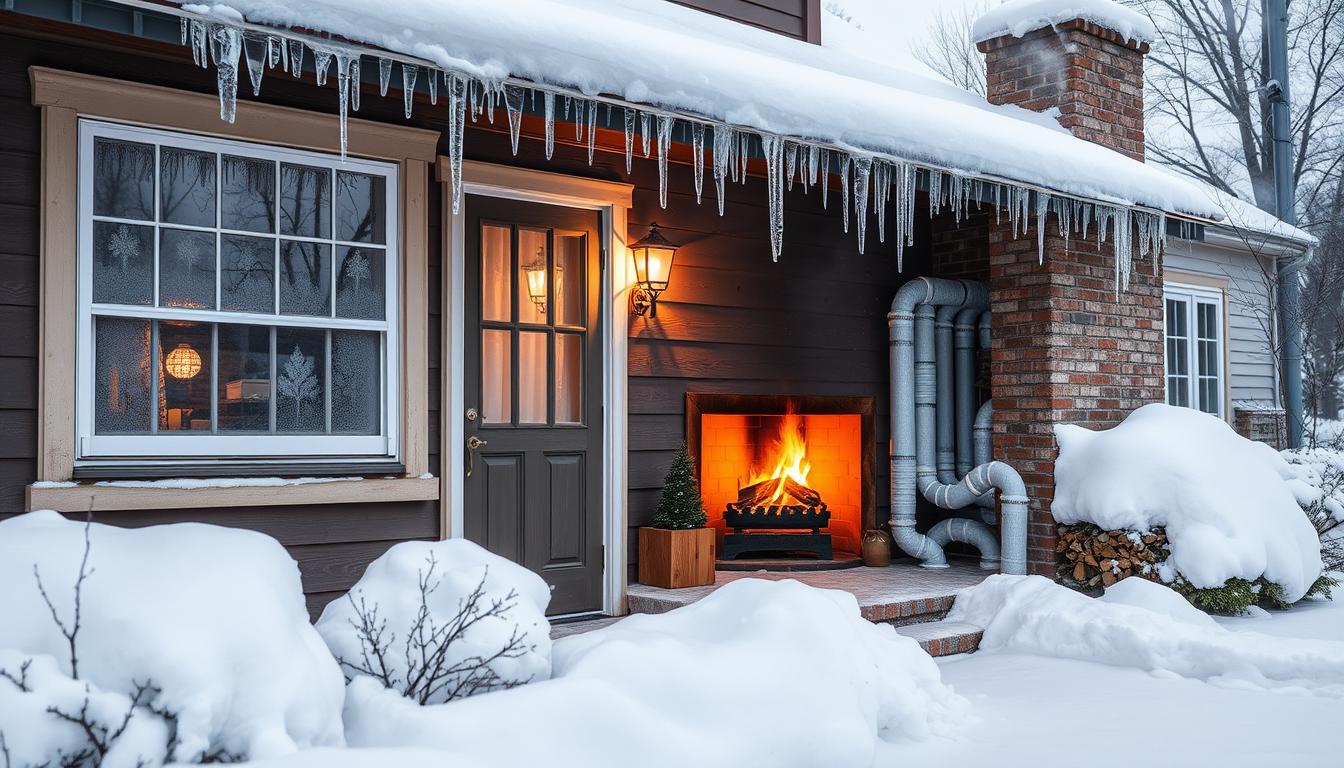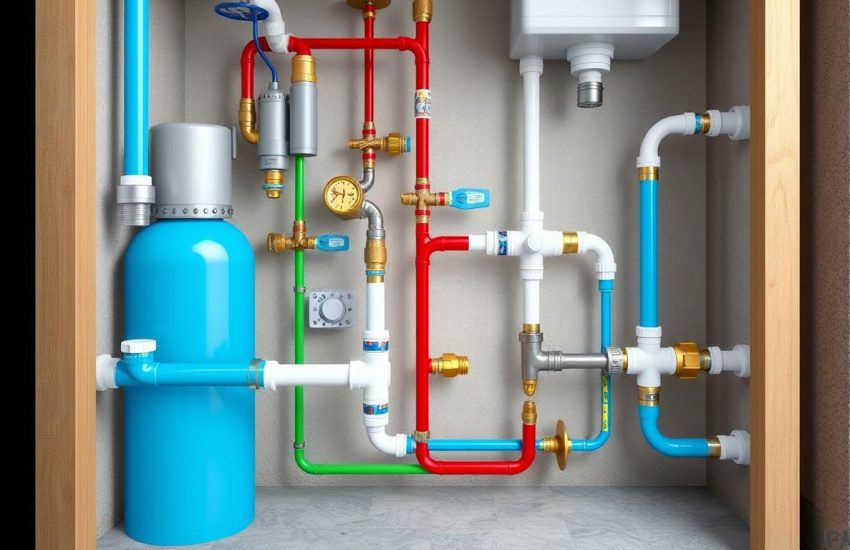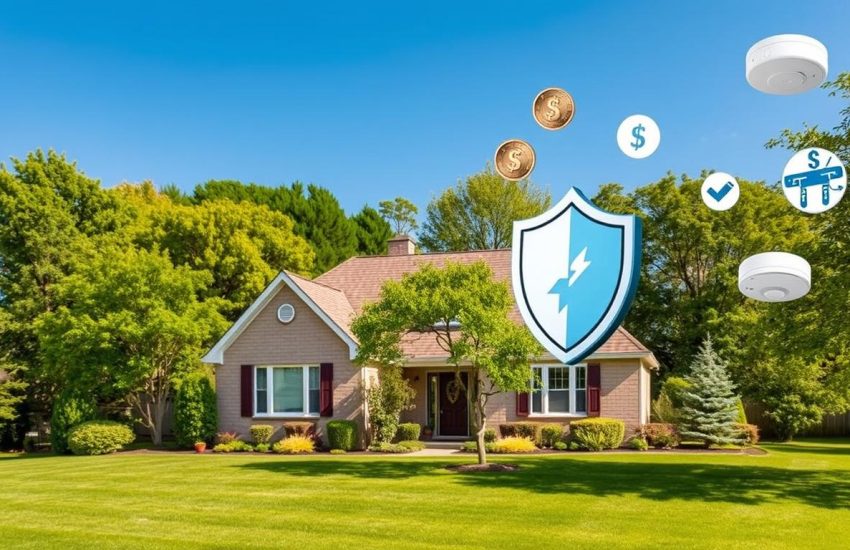Winter-Proofing Your Home: A Complete Guide for Homeowners
When frost glazes our windows, we must ask: is our home ready for winter? Preparing for cold weather means keeping warm, saving on energy, and being at peace. Did you know making small changes can keep you stay cozy and cut costs when winter comes?
Ready to start? You might fix things yourself or get professional help. First, have a plan. Protect your pipes and make sure your furnace works well in winter. Getting your home ready takes careful thought and action. Let’s look into making your home warm and safe for winter. It’s more than just insulation or stopping cold drafts. It’s about caring for your house and everyone in it.
Key Takeaways
- How setting your thermostat to 68 degrees Fahrenheit while at home can optimize energy usage and comfort.
- The importance of annual fireplace inspections and gutter maintenance to prevent structural damage.
- Ways that smart investments like LED bulbs, water heater blankets, and window insulation kits can lead to long-term savings.
- The statistical proof that winter-proofing not only lowers energy bills but may also boost your property value.
- Preventative measures, such as programmable thermostats and pipe insulation, that keep the cold out and the warmth in.
- How to proactively prepare with emergency kits and supplies to stay ahead of winter’s unpredictability.
Why Focus on Winter-Proofing Your Home?
The need to focus on DIY winter-proofing your home is important. Especially since homes lose a lot of heat if not sealed well. This can lead to higher energy costs and lessen the cozy living environment.
Weatherization helps keep warm air in and cold air out. This makes your home warm and saves energy. Using double-pane windows and sealants around doors are good steps.
Steps like adding insulation and sealing air leaks are vital. They keep you comfortable and safe. It’s important to protect pipes from freezing to avoid water damage.
| Improvement | Benefits | Cost |
|---|---|---|
| Duck Heavy-Duty Weatherstrip Seal | Seals door drafts effectively | $7 |
| DeeTool Door Draft Stopper | Blocked gaps along door bottoms | $18 |
| Acrylic latex/silicone caulk | Seals window and door gaps | $6 per tube |
| Safavieh Rugs | Floor insulation and aesthetics | Varies |
These facts show how effective winterization is at lowering heating costs. It helps save money and keeps homes cozy. You enjoy better comfort indoors and lower energy bills each month.
So, making your home winter-ready is wise. It’s good for both your wallet and the planet all year round.
DIY vs Professional Help
When thinking about affordable winter-proofing your home, decide if you should DIY or hire professional winter-proofing services. Your choice depends on how complex the task is and if you feel confident doing it yourself.
DIY tasks like bleeding radiators or installing panels behind them are simple. They help your heating system work better and lower your bills. Sealing gaps with caulk and adding weather stripping also keeps the cold out easily.
But for tough jobs like chimney cleaning or fixing blocked gutters, it’s smart to get professional help. Experts have the right gear and know-how to do these jobs safely and well. This prevents problems and keeps your home safe.
- Bleeding radiators improves heating and is an easy job you can do yourself.
- Putting reflective panels behind radiators stops heat loss and is great for a DIY project.
- Experts should do yearly boiler checks and clean gutters to avoid issues later on.
Mixing DIY and professional help is a good strategy for home improvement. Tackle the easy fixes yourself. But for big jobs, experts make sure your home is ready for winter without issues.
| Task | DIY | Professional Help |
|---|---|---|
| Boiler Service | No | Yes |
| Gutter Cleaning | Possible | Recommended |
| Reflective Panels Installation | Yes | No |
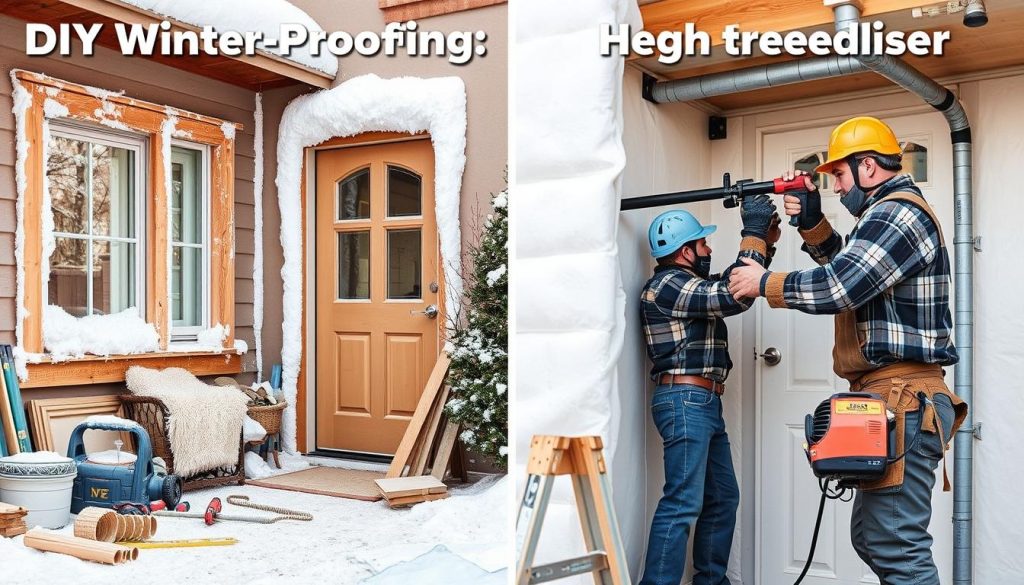
In the end, while doing it yourself can save money and feel good, some jobs need experts. Both ways help keep your home warm, safe, and energy-smart in winter.
How to Save Money
When it gets cold, finding ways to save money on winter-proofing your home is key. Homeowners want to cut utility costs. By choosing smart upgrades, your home gets warmer and your heating bill drops.
Adding insulation to your water heater and pipes helps a lot. It can make your water 2 to 4°F warmer. So, you’ll use less energy while keeping your showers warm.
Don’t forget about your attic. It’s often not insulated enough, leading to heat loss. Proper insulation can cut your energy bill by up to 50%. It keeps heat in and stops ice dams in winter.
Keeping your home at the right temperature saves energy too. Set your thermostat to 68 degrees when you’re home. Turn it down when you’re away or sleeping. This trick can save you about $50 for every degree you adjust.
Installing low-E storm windows is a smart move. They can save you 10% to 15% on energy. The Department of Energy says they can even save up to 30%.
Here’s a simple list of how energy-efficient upgrades can save you money:
| Upgrade | Cost Saving (%) | Additional Benefit |
|---|---|---|
| Insulating Attic | Up to 50% | Prevents ice dams |
| Adjusting Thermostat | $50/year per degree | Optimal comfort |
| Low-E Storm Windows | Up to 30% | Comparable to new windows |
But there’s more you can do. Think about a professional energy check. Also, check how to save more on winter-proofing. Getting advice and using insurance or warranties can save you even more.
By taking these steps, your home gets cozier and you help the planet too. This winter, make smart choices to keep your home warm and efficient.
Step-by-Step Upgrades
Making your home winter-proof step-by-step adds comfort and saves energy in the cold months. Starting this means using smart strategies to keep your home warm and stop heat from escaping.
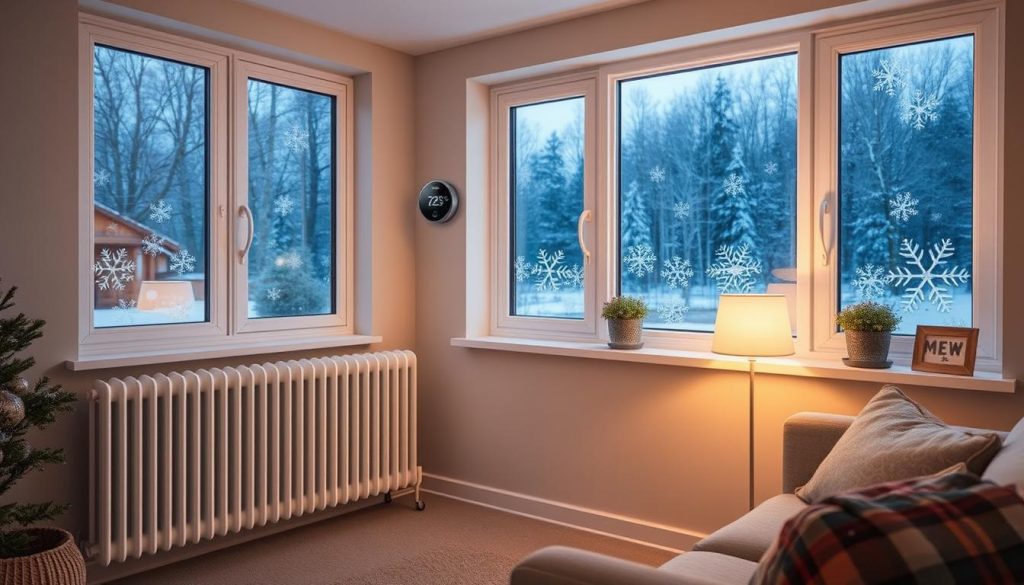
To start, improving windows with good thermal treatments cuts down on heat loss. For example, shutters cut heat loss through windows by 36%. Roman blinds and blackout curtains reduce it by 21% and 14% each. These options make your home warmer and more beautiful too.
| Upgrade | Heat Loss Reduction | Estimated Annual Savings |
|---|---|---|
| Cavity wall insulation | Effective throughout the home | $210 |
| Loft insulation | Reduces rising heat loss | $200 |
| Floor insulation | Prevents ground-level heat loss | $60 |
| Smart thermostats | Optimizes home heating efficiency | $95 |
Insulating your plumbing is key for winter. Covering pipes with foam stops them from freezing. It also prevents little heat losses that add up over time.
Keep radiators working well by bleeding them twice a year. Also, make sure your boiler pressure is right. This makes your heating better.
Just lowering your thermostat a tiny bit saves money. Dropping the temp by 1°C could cut your heating bill by 10%.
Every step, from better window treatments to smarter heating, means more savings. And, it makes your home feel cozier.
Final Tips for Success
Want to keep your home warm in winter? Focus on the small stuff. Seal air leaks in walls, windows, and doors. Tiny gaps let out a lot of heat. Use weather tape, plastic films, and foam gaskets to close these leaks. Remember, even outlets on outside walls can leak heat. A simple foam gasket can save energy.
Your floors can help keep the house warm, too. Put down rugs and bath mats. This can keep your floors warm and can cut heating costs by 20 percent. Thick curtains help too. They stop cold air and keep your rooms warm. For more tips, check out our full guide on preparing your home for.
Regular checks for insulation problems are vital. Fix any weak spots right away. This keeps your heating costs down and your home systems healthy. Every step, like adding storm doors or wrapping pipes, makes your home warmer in the cold months. Work on saving energy, and your house will become a warm, efficient place.

